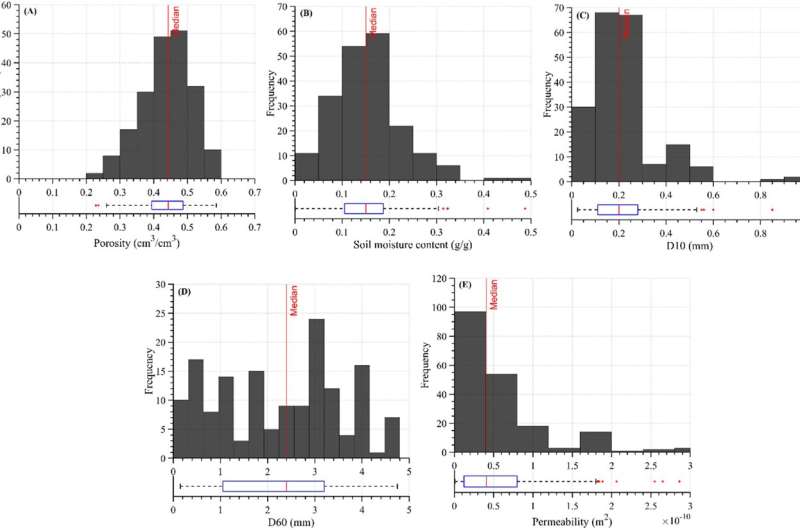Study reveals soil moisture plays the biggest role in underground spread of natural gas leaking from pipelines

Soil moisture content is the main factor that controls how far and at what concentration natural gas spreads from a leaked pipeline underground, a new study has found.
Pipeline operators need to factor how the amount of water found in surrounding soil affects gas movement when trying to determine the potential hazards posed by a pipeline leak, said SMU's Kathleen M. Smits, who led the study recently published in the journal Elementa that examined soil properties from 77 locations around the country where a gas leakage had occurred.
"We don't need to look any further than Dallas or Georgetown, Texas to see where underground pipeline leaks have the potential to result in catastrophic outcomes," said Smits, SMU Lyle School of Engineering Chair of Civil and Environmental Engineering and Solomon Professor for Global Development. "We often see that such incidents are the result of a lack of clear protocols to detect the leaks or assess damage. That's why there should be more focus on the importance of environmental factors such as soil moisture and how to properly account for them in leak scenarios."
In general the team, co-led by Younki Cho, a research scientist at Colorado State University's Energy Institute, found that methane gas leaking from a pipeline does not spread as far when the soil moisture content increases. That results in a higher concentration of methane gas close to the leak site in more moist soil, the study revealed.
The opposite was true with drier soil.
But Smits stressed that simply knowing how wet the ground is at the time of the leak is not enough to make conclusions about how soil moisture content impacts gas movement. The moistness of the soil—or lack thereof—at the time of leak triggers different complex behaviors in the soil when methane gas seeps into the same spaces as water and oxygen in the pores of the soil. Soil moisture content can also change over time because of weather and other factors such as seasonal water table levels.
"You have to understand how the moisture controls both the movement and concentration together," Smits said. "This is something we can assist [pipeline owners] with going forward in addressing leak incidents."
The research team looked at more than 300 soil samples from leak sites around the country. The samples—which were taken at the time of the leak and again after the leak was repaired—were weighed when they were wet. They were also weighed a second time after they had been dried out in an oven.
"The difference in the dry and wet weights, linked with knowledge of the volume of the soil sample, allowed us to calculate the soil moisture," Smits explained.
Other soil qualities like its texture and permeability were also examined by the team, but did not demonstrate as much impact on how natural gas moved belowground.
Walking surveys better at finding pipeline leaks than mobile detection under certain circumstances
In another study aimed at improving gas leak detection, Smits and researchers from CSU's Energy Institute found that there are instances where operating a mobile detection unit from the front or roof of a car were not as effective as walkers carrying a handheld detection instrument.
In a mobile survey, the detection unit measures for elevated levels of methane gas in the air as the car is driving. A higher traveling speed or wind speed outside the car resulted in a lowered probability of leak detection when compared to a foot patrol.
"For example, if you just isolated the speed of travel—comparing a person walking at 2 to 3 miles per hour versus a car driving at a slow speed of 20 to 30 mph—the probability of detecting a leak drops from 85% for a walking survey to 25% for a car," Smits said.
The study, published in the journal Environmental Pollution, showed that atmospheric stability also had an effect on mobile surveys.
Atmospheric stability essentially determines whether air will rise, sink, or do nothing. Warm, less dense air rises (unstable), while cooler, more dense air sinks (stable). Air staying at the same altitude is considered neutral.
Researchers found that mobile surveys conducted at speeds between 2 to 11 miles per hour got progressively less effective (from 85% to 60%) at finding a leak as the atmospheric stability went from extremely unstable conditions to extremely stable. Walking surveys conducted under these same conditions did not reflect variability.
"Walking surveys find the most leaks, by far, but they are labor intensive and cost a lot of money," Smits noted. "This study shows that if operators want to use another method such as a mobile survey, they need to thoughtfully choose a suitable survey speed under different weather conditions to achieve a detection probability equivalent to the traditional walking survey."
The findings could apply to any type of buried pipeline, Smits said.
More information: Younki Cho et al, A closer look at underground natural gas pipeline leaks across the United States, Elementa: Science of the Anthropocene (2022). DOI: 10.1525/elementa.2021.00095
Shanru Tian et al, Investigating detection probability of mobile survey solutions for natural gas pipeline leaks under different atmospheric conditions, Environmental Pollution (2022). DOI: 10.1016/j.envpol.2022.120027
Journal information: Environmental Pollution
Provided by Southern Methodist University





















